Finally the blue skies have returned. We're anchored in St. Andrews Bay, the skyline dominated by the Heaney Glacier in the middle and the Cook Glacier on the left. This is the place where we'll find the largest king penguin colony of South Georgia.

Because of the shallow waters in the bay we're facing a long zodiac ride towards the shore. The relatively high waves and the strong wind make the ride bumpy and wet. The wind doesn't decrease on reaching the shore. We're being sandblasted! The wind even topples my tripod with camera. Fortunately I can save it without damage but my cap takes its opportunity and drifts away. Just before it disappears into the waves somebody manages to rescue it.
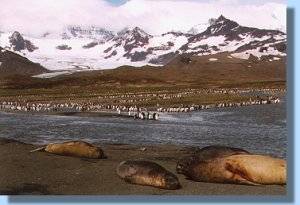
The beach we're on looks like a sandbar, being only 10 meters wide. Behind it a reasonably wide river carries glacial melt off to the sea. On its shore we encounter the first king penguins. Behind them there's a large grassy plain with a couple of reindeer (!) and a former BAS rescue hut. This hut was used as a shelter during a sudden storm on a previous Cheesemans' trip.
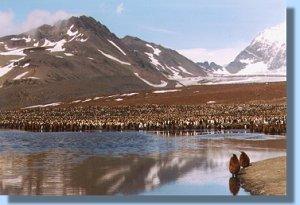
We walk eastwards along the beach and soon we're witnessing a breathtaking scenery. Hundreds of thousands of king penguins! As far as the eye can see the area is filled with the black, white and yellow of adult kings and their brown fuzzy young.
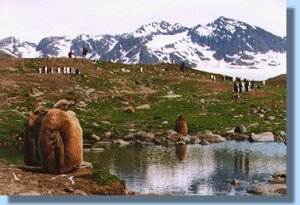 A rapidly flowing glacial river separates the colony in two halves.
The 2000 meter high peaks and the Heaney and Cook glaciers make the
picture complete.
A rapidly flowing glacial river separates the colony in two halves.
The 2000 meter high peaks and the Heaney and Cook glaciers make the
picture complete.
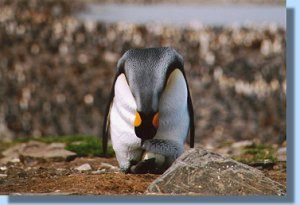
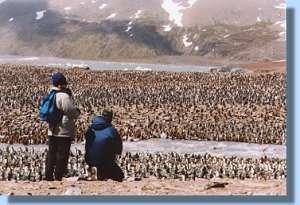 On top of a hill overlooking the colony the sights are even more spectacular.
Just in front of us an adult penguin is breeding. Our patience is rewarded by
a few glances on its egg balancing on the king's feet.
On top of a hill overlooking the colony the sights are even more spectacular.
Just in front of us an adult penguin is breeding. Our patience is rewarded by
a few glances on its egg balancing on the king's feet.
The river turns out to be a nice viewing spot. Every now and then a king penguin tries to cross the rapidly flowing river. Often the currents are too strong knocking the poor penguin off its feet. It's pretty hilarious to see the penguin floating by in a frantic attempt to reach the other shore before it ends up in the sea.
In the meantime the mountain peaks in front of us seem to have acquired a white blanket. At the same time the winds increase in force. Shortly after we're warned by members of the staff to return to the landing site.
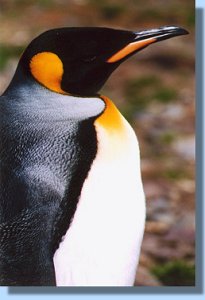
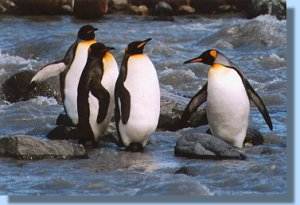
The cloud cover and the increasing winds are the early warning signs of katabatic winds. These winds are driven by cold air "falling down" the glaciers and are potentially dangerous. With no shelter on the beach and high waves in the bay's shallow waters we have to go back to the ship before it's not possible anymore. In 1999 a number of people were trapped for about 8 hours due to katabatic winds in the BAS-hut mentioned before.
Almost everybody is already on board and only two zodiacs are left on shore. The strong winds cause high waves and during the ride we're again sprayed by lots of water. Arriving at the side of the Polar Star the waves are dangerously high threatening to trap us underneath the gangway. The captain suggests to move the ship to deeper waters were the waves probably will be lower.
Still out we see the anchor being lifted and slowly the Polar Star turns and starts sailing away from us much to the surprise of the people on the observation desk who are probably oblivious of our conversations with the captain. We follow the ship for quite some time and manage
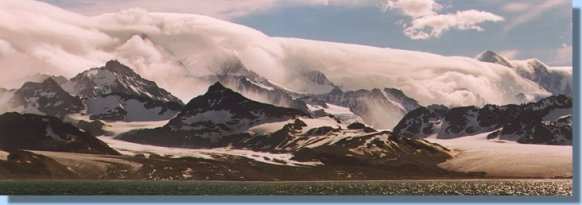
to reach the ship again after it has stopped in deeper waters. Although the waves are still high we now manage to get on board safely. Immediately after the people in the second zodiac have arrived on board safely too, we leave for our next destination.
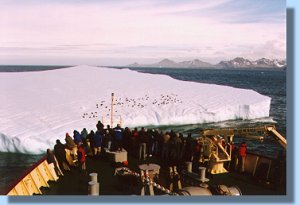
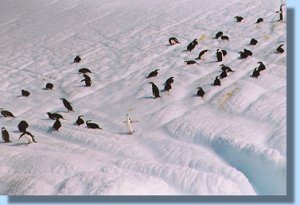
Outside St. Andrews Bay, three icebergs are floating. The captain approaches the first one to about 50 meters. With a surface area comparable
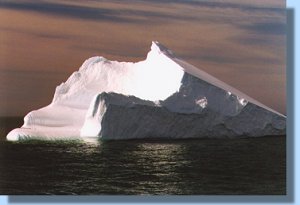 to our ship it's quite a berg.
to our ship it's quite a berg.
On the top several tens of chinstrap penguins have found a nice spot for their ocean cruise.
After a while we also visit a second iceberg. This one is considerably higher than our ship and we keep a much larger distance. Plenty of chinstraps can be seen on this one as well.
In the meantime the ship's crew is preparing a BBQ on the observation desk. Sailing towards Cooper Bay, our next destination, we enjoy the scenery of South Georgia with its ragged peaks on our right and several icebergs on our left. The sun and the steaks from the BBQ form the finishing touch.